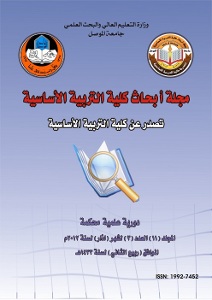The Effect of Using Woods’ Model on the Achievement of Fifth Scientific Grade Students in Physics and Developing Their Critical Thinking
Abstract
. . (71) , (35 , 36) , (, , , ) . . : (45) () ( ) . (75) (5) ( , , , , ) . : 1- .2- .The Effect of Using Woods Model on the Achievement of Fifth Scientific Grade Students in Physics and Developing Their Critical ThinkingAssistant Professor Dr. Ahmed Jawher M. Researcher Radwan M. Mustafa College of Education / University of MosulAbstract:The study aimed at knowing the effect of using Woods model on the achievement of fifth scientific grade students in physics and developing their critical thinking . To achieve this objective , two null hypotheses have been formed . And to examine the validity of the two hypotheses , a sample of (71) students has been chosen from the scientific fifth grade in Al-Markazya secondary school for boys. The sample is divided into two groups the first one is the experimental group and the second one is the control group consisting of (35 36) students respectively. The two groups have undergone to equivalence process in variables of (intelligence, achievement of physics during last year, the age and the critical thinking). The experimental group has been taught according to Woods Model and the control group in the traditional method .The study required two tools, the first one is represented in an acquisitive test in physics, consisting of (45) objective test items of matching type and multiple choices to fill blanks. The second tool is the critical thinking test, consists which of (75) testing items distributed into (5) fields of testing the critical thinking abilities represented in the skills of (concluding, assessing evidence, knowing the hypotheses, deduction and interpretation) .Collecting and statistically analyzing the data , the two researchers have reached the following results:1. There is a statistical difference between the two groups of the study in achievement of physics for the sake of the experimental group .2. There is a statistical difference between the two groups of the study in developing critical thinking for the sake of the experimental group .
